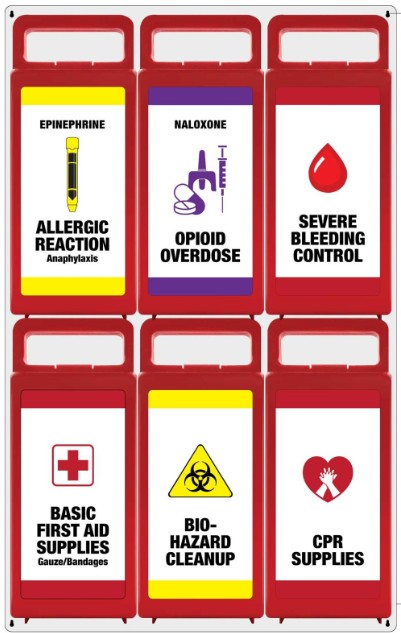HHS and GSA Update Guidelines for Federal Safety Stations to Improve Health and Safety, Facilitate Overdose Prevention
Expanding Access to Life-Saving Opioid Overdose Reversal Medications Like Naloxone and Hemorrhagic Control Like Stop the Bleed® Washington, D.C.- Today, the U.S. Department of Health and Human Services (HHS) and the U.S. General Services Administration (GSA) announced the first updated guidelines for safety stations in federal facilities in the past 15 years. This expands the existing recommendation beyond automated external defibrillators (AED) to also include opioid reversal agents such as naloxone and hemorrhagic control such as Stop the Bleed® (STB). Overdose reversal medications that can reverse an opioid-involved overdose, including a fentanyl-involved overdose, can be found in many schools, libraries, and other community institutions and should be readily available in and around federal buildings. Hemorrhagic control provides immediate post-injury care in the recognition and treatment of a bleeding emergency. Access to bleeding control equipment is beneficial to occupants of federal facilities. “These updated guidelines are based on the best available science and represent a flexible and collective response as a federal family,” said HHS Assistant Secretary for Health ADM Rachel L. Levine. “An emergency can happen in any setting, including our workplaces. We all need to be prepared to save a life anytime, anywhere.” “Today’s actions represent a federal partnership that not only provides the framework for expanding access to additional life-saving equipment in federal facilities, but also offers the acquisition resources to develop and maintain those safety stations,” said GSA Associate Administrator for Government-wide Policy Krystal Brumfield, the agency’s Chief Acquisition Officer. “These updated safety stations can make a critical difference, and help our workforce get home to their families if there is ever an emergency.” The updated guidelines expand the concept of an AED program by introducing the “safety station,” which would enable anyone located within a federal facility to access the necessary tools quickly and easily to respond to an emergency situation. Under the new recommendation, anywhere that an AED was previously located can and should be converted to a safety station. Each safety station is recommended to include an AED and supporting equipment at a minimum. It is now highly recommended that each station also includes either a bystander-empowered opioid reversal agent or hemorrhagic control component, or both. The primary purpose of these guidelines is to provide a general framework for establishing a design process for safety station programs in Federal facilities. A secondary purpose is to familiarize federal agencies with the three modular bystander-empowered components and the essential elements associated with each component of such a program. The design of a safety station program for any federal facility will be unique and depends on many factors, including the population demographics of the facility, the size and location of the facility and the surrounding area. These guidelines are intended to provide a foundation upon which individually tailored programs are established and maintained. The safety station program is voluntary and not mandatory for federal facilities. The costs and expenses to establish and operate a safety station program are the responsibility of the federal agency or agencies sponsoring the program. Read the Federal Management Regulation. Read the Safety Station Fact Sheet for Federal Employees and Contractors | HHS.gov About HHS: The mission of the U.S. Department of Health and Human Services is to enhance the health and well-being of all Americans, by providing for effective health and human services and by fostering sound, sustained advances in the sciences underlying medicine, public health, and social services. About GSA: GSA provides centralized procurement and shared services for the federal government, managing a nationwide real estate portfolio of nearly 370 million rentable square feet, overseeing over $100 billion in products and services via federal contracts, and delivering technology services that serve millions of people across dozens of federal agencies. GSA’s mission is to deliver the best customer experience and value in real estate, acquisition, and technology services to the government and the American people. For more information, visit GSA.gov and follow us at @USGSA . ###



